Pandas를 사용한 JIRA 분석
Problem
It's hard to argue Atlassian JIRA is one of the most popular issue trackers and project management solutions. You can love it, you can hate it, but if you were hired as a software engineer for some company, there is a high probability of meeting JIRA.
If the project you are working on is very active, there can be thousands of JIRA issues of various types. If you are leading a team of engineers, you can be interested in analytical tools that can help you understand what is going on in the project based on data stored in JIRA. JIRA has some reporting facilities integrated, as well as 3rd party plugins. But most of them are pretty basic. For example, it's hard to find rather flexible "forecasting" tools.
The bigger the project, the less satisfied you are with integrated reporting tools. At some point, you will end up using an API to extract, manipulate, and visualize the data. During the last 15 years of JIRA usage, I saw dozens of such scripts and services in various programming languages around this domain.
Many day-to-day tasks may require one-time data analysis, so writing services every time doesn't pay off. You can treat JIRA as a data source and use a typical data analytics tool belt. For example, you may take Jupyter, fetch the list of recent bugs in the project, prepare a list of "features" (attributes valuable for analysis), utilize pandas to calculate the statistics, and try to forecast trends using scikit-learn. In this article, I would like to explain how to do it.
Preparation
JIRA API Access
Here, we will talk about the cloud version of JIRA. But if you are using a self-hosted version, the main concepts are almost the same.
First of all, we need to create a secret key to access JIRA via REST API. To do so, go to profile management - https://id.atlassian.com/manage-profile/profile-and-visibility If you select the "Security" tab, you will find the "Create and manage API tokens" link:

Create a new API token here and store it securely. We will use this token later.
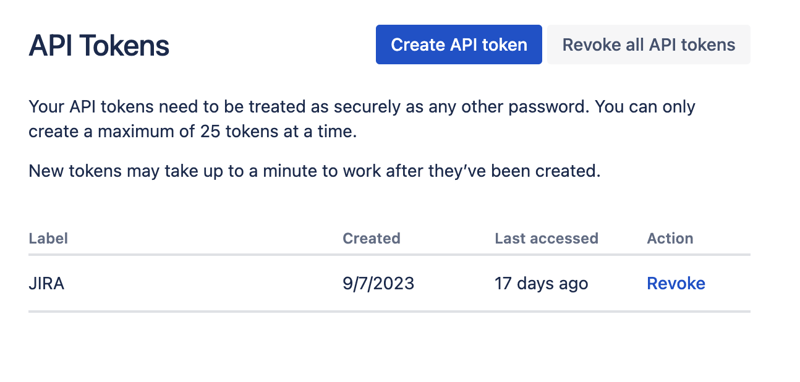
Jupyter Notebooks
One of the most convenient ways to play with datasets is to utilize Jupyter. If you are not familiar with this tool, do not worry. I will show how to use it to solve our problem. For local experiments, I like to use DataSpell by JetBrains, but there are services available online and for free. One of the most well-known services among data scientists is Kaggle. However, their notebooks don't allow you to make external connections to access JIRA via API. Another very popular service is Colab by Google. It allows you to make remote connections and install additional Python modules.
JIRA has a pretty easy-to-use REST API. You can make API calls using your favorite way of doing HTTP requests and parse the response manually. However, we will utilize an excellent and very popular jira module for that purpose.
Tools in Action
Data Analysis
Let's combine all the parts to come up with the solution.
Go to the Google Colab interface and create a new notebook. After the notebook creation, we need to store previously obtained JIRA credentials as "secrets." Click the "Key" icon in the left toolbar to open the appropriate dialog and add two "secrets" with the following names: JIRA_USER and JIRA_PASSWORD. At the bottom of the screen, you can see the way how to access these "secrets":

The next thing is to install an additional Python module for JIRA integration. We can do it by executing the shell command in the scope of the notebook cell:
!pip install jira
The output should look something like the following:
Collecting jira
Downloading jira-3.8.0-py3-none-any.whl (77 kB)
━━━━━━━━━━━━━━━━━━━━━━━━━━━━━━━━━━━━━━━━ 77.5/77.5 kB 1.3 MB/s eta 0:00:00
Requirement already satisfied: defusedxml in /usr/local/lib/python3.10/dist-packages (from jira) (0.7.1)
...
Installing collected packages: requests-toolbelt, jira
Successfully installed jira-3.8.0 requests-toolbelt-1.0.0
We need to fetch the "secrets"/credentials:
from google.colab import userdata
JIRA_URL = 'https://******.atlassian.net'
JIRA_USER = userdata.get('JIRA_USER')
JIRA_PASSWORD = userdata.get('JIRA_PASSWORD')
And validate the connection to the JIRA Cloud:
from jira import JIRA jira = JIRA(JIRA_URL, basic_auth=(JIRA_USER, JIRA_PASSWORD)) projects = jira.projects() projects
If the connection is ok and the credentials are valid, you should see a non-empty list of your projects:
[, , , ...
So we can connect and fetch data from JIRA. The next step is to fetch some data for analysis with pandas. Let’s try to fetch the list of solved problems during the last several weeks for some project:
JIRA_FILTER = 19762
issues = jira.search_issues(
f'filter={JIRA_FILTER}',
maxResults=False,
fields='summary,issuetype,assignee,reporter,aggregatetimespent',
)
We need to transform the dataset into the pandas data frame:
import pandas as pd
df = pd.DataFrame([{
'key': issue.key,
'assignee': issue.fields.assignee and issue.fields.assignee.displayName or issue.fields.reporter.displayName,
'time': issue.fields.aggregatetimespent,
'summary': issue.fields.summary,
} for issue in issues])
df.set_index('key', inplace=True)
df
The output may look like the following:
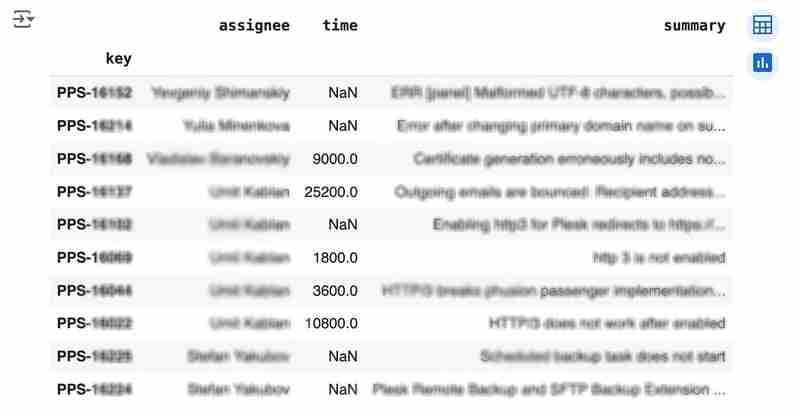
We would like to analyze how much time it usually takes to solve the issue. People are not ideal, so sometimes they forget to log the work. It brings a headache if you try to analyze such data using JIRA built-in tools. But it's not a problem for us to make some adjustments using pandas. For example, we can transform the "time" field from seconds into hours and replace the absent values with the median value (beware, dropna can be more suitable if there are a lot of gaps):
df['time'].fillna(df['time'].median(), inplace=True) df['time'] = df['time'] / 3600
We can easily visualize the distribution to find out anomalies:
df['time'].plot.bar(xlabel='', xticks=[])
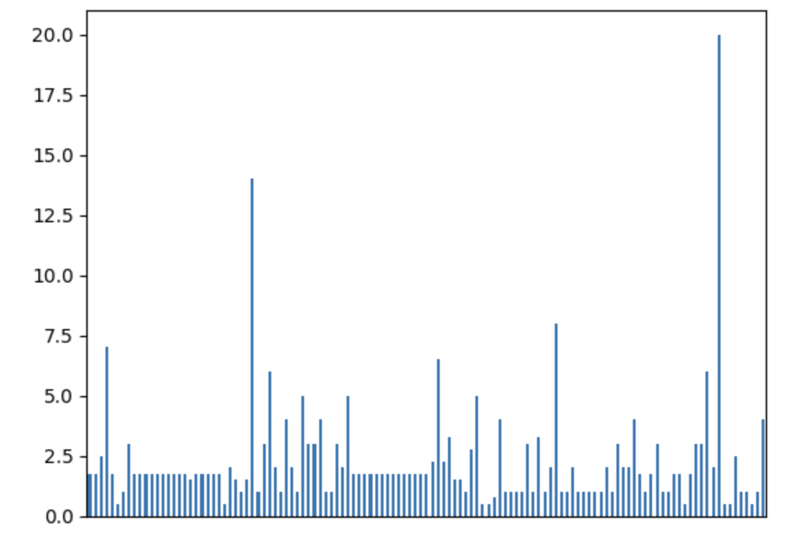
It is also interesting to see the distribution of solved problems by the assignee:
top_solvers = df.groupby('assignee').count()[['time']]
top_solvers.rename(columns={'time': 'tickets'}, inplace=True)
top_solvers.sort_values('tickets', ascending=False, inplace=True)
top_solvers.plot.barh().invert_yaxis()
It may look like the following:
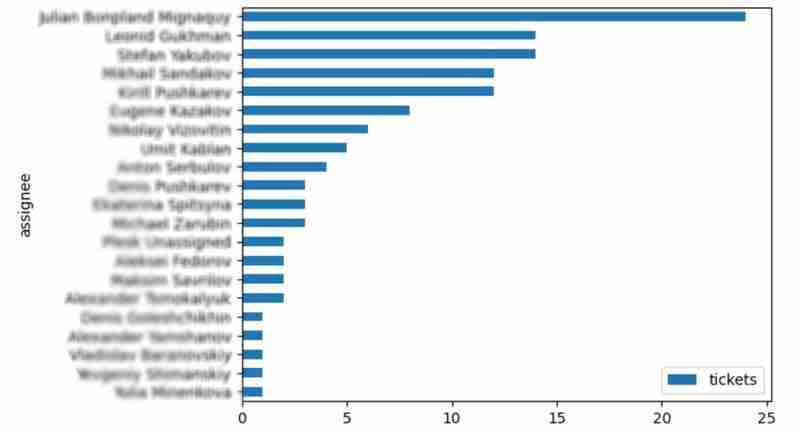
Predictions
Let's try to predict the amount of time required to finish all open issues. Of course, we can do it without machine learning by using simple approximation and the average time to resolve the issue. So the predicted amount of required time is the number of open issues multiplied by the average time to resolve one. For example, the median time to solve one issue is 2 hours, and we have 9 open issues, so the time required to solve them all is 18 hours (approximation). It's a good enough forecast, but we might know the speed of solving depends on the product, team, and other attributes of the issue. If we want to improve the prediction, we can utilize machine learning to solve this task.
The high-level approach looks the following:
- Obtain the dataset for “learning”
- Clean up the data
- Prepare the "features" aka "feature engineering"
- Train the model
- Use the model to predict some value of the target dataset
For the first step, we will use a dataset of tickets for the last 30 weeks. Some parts here are simplified for illustrative purposes. In real life, the amount of data for learning should be big enough to make a useful model (e.g., in our case, we need thousands of issues to be analyzed).
issues = jira.search_issues(
f'project = PPS AND status IN (Resolved) AND created >= -30w',
maxResults=False,
fields='summary,issuetype,customfield_10718,customfield_10674,aggregatetimespent',
)
closed_tickets = pd.DataFrame([{
'key': issue.key,
'team': issue.fields.customfield_10718,
'product': issue.fields.customfield_10674,
'time': issue.fields.aggregatetimespent,
} for issue in issues])
closed_tickets.set_index('key', inplace=True)
closed_tickets['time'].fillna(closed_tickets['time'].median(), inplace=True)
closed_tickets
In my case, it's something around 800 tickets and only two fields for "learning": "team" and "product."
The next step is to obtain our target dataset. Why do I do it so early? I want to clean up and do "feature engineering" in one shot for both datasets. Otherwise, the mismatch between the structures can cause problems.
issues = jira.search_issues(
f'project = PPS AND status IN (Open, Reopened)',
maxResults=False,
fields='summary,issuetype,customfield_10718,customfield_10674',
)
open_tickets = pd.DataFrame([{
'key': issue.key,
'team': issue.fields.customfield_10718,
'product': issue.fields.customfield_10674,
} for issue in issues])
open_tickets.set_index('key', inplace=True)
open_tickets
Please notice we have no "time" column here because we want to predict it. Let's nullify it and combine both datasets to prepare the "features."
open_tickets['time'] = 0 tickets = pd.concat([closed_tickets, open_tickets]) tickets
Columns "team" and "product" contain string values. One of the ways of dealing with that is to transform each value into separate fields with boolean flags.
products = pd.get_dummies(tickets['product'], prefix='product')
tickets = pd.concat([tickets, products], axis=1)
tickets.drop('product', axis=1, inplace=True)
teams = pd.get_dummies(tickets['team'], prefix='team')
tickets = pd.concat([tickets, teams], axis=1)
tickets.drop('team', axis=1, inplace=True)
tickets
The result may look like the following:
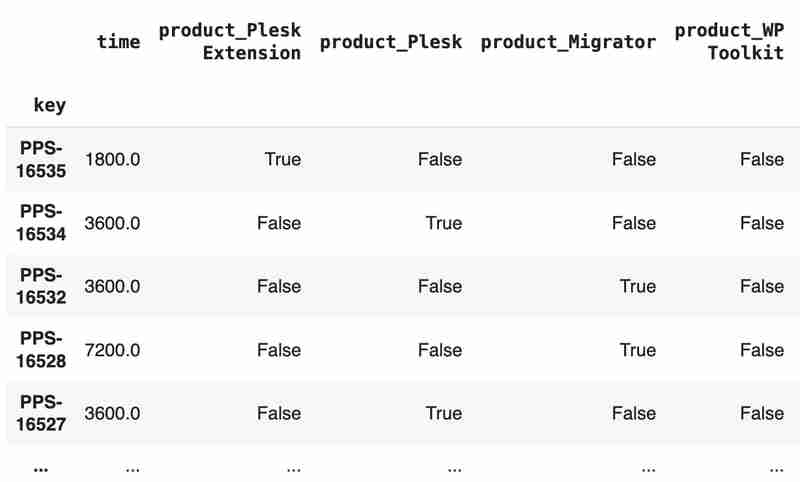
After the combined dataset preparation, we can split it back into two parts:
closed_tickets = tickets[:len(closed_tickets)] open_tickets = tickets[len(closed_tickets):][:]
Now it's time to train our model:
from sklearn.model_selection import train_test_split from sklearn.tree import DecisionTreeRegressor features = closed_tickets.drop(['time'], axis=1) labels = closed_tickets['time'] features_train, features_val, labels_train, labels_val = train_test_split(features, labels, test_size=0.2) model = DecisionTreeRegressor() model.fit(features_train, labels_train) model.score(features_val, labels_val)
And the final step is to use our model to make a prediction:
open_tickets['time'] = model.predict(open_tickets.drop('time', axis=1, errors='ignore'))
open_tickets['time'].sum() / 3600
The final output, in my case, is 25 hours, which is higher than our initial rough estimation. This was a basic example. However, by using ML tools, you can significantly expand your abilities to analyze JIRA data.
Conclusion
Sometimes, JIRA built-in tools and plugins are not sufficient for effective analysis. Moreover, many 3rd party plugins are rather expensive, costing thousands of dollars per year, and you will still struggle to make them work the way you want. However, you can easily utilize well-known data analysis tools by fetching necessary information via JIRA API and go beyond these limitations. I spent so many hours playing with various JIRA plugins in attempts to create good reports for projects, but they often missed some important parts. Building a tool or a full-featured service on top of JIRA API also often looks like overkill. That's why typical data analysis and ML tools like Jupiter, pandas, matplotlib, scikit-learn, and others may work better here.
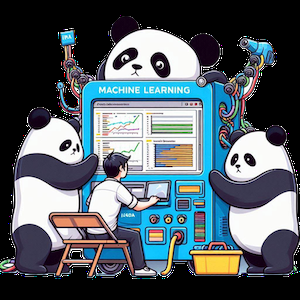
-
 추천 프로젝트: 인사관리 시스템 데이터베이스 구축LabEx의 이 포괄적인 프로젝트는 인사 관리 시스템의 생성 및 구현에 중점을 두고 데이터베이스 관리의 세계를 탐구할 수 있는 귀중한 기회를 제공합니다. 신진 데이터베이스 관리자이든 노련한 개발자이든 이 실습 경험을 통해 관계형 데이터베이스 환경 내에서 데이터를 효과적...프로그램 작성 2024-11-06에 게시됨
추천 프로젝트: 인사관리 시스템 데이터베이스 구축LabEx의 이 포괄적인 프로젝트는 인사 관리 시스템의 생성 및 구현에 중점을 두고 데이터베이스 관리의 세계를 탐구할 수 있는 귀중한 기회를 제공합니다. 신진 데이터베이스 관리자이든 노련한 개발자이든 이 실습 경험을 통해 관계형 데이터베이스 환경 내에서 데이터를 효과적...프로그램 작성 2024-11-06에 게시됨 -
 Python의 인스턴스 메소드와 클래스 메소드의 차이점은 무엇입니까?클래스와 인스턴스 메서드 비교Python의 PEP 8 스타일 가이드에서는 인스턴스 메서드 첫 번째 인수에 "self"를 사용하고 클래스에 "cls"를 사용하도록 권장합니다. 메소드의 첫 번째 인수. 효과적인 객체 지향 프로그래밍을 위...프로그램 작성 2024-11-06에 게시됨
Python의 인스턴스 메소드와 클래스 메소드의 차이점은 무엇입니까?클래스와 인스턴스 메서드 비교Python의 PEP 8 스타일 가이드에서는 인스턴스 메서드 첫 번째 인수에 "self"를 사용하고 클래스에 "cls"를 사용하도록 권장합니다. 메소드의 첫 번째 인수. 효과적인 객체 지향 프로그래밍을 위...프로그램 작성 2024-11-06에 게시됨 -
 AdoptiumJDK 소스 코드를 Eclipse IDE에 로드AdoptiumJDK에는 설치 프로그램에 소스 코드 파일이 내장되어 있지 않으며 Eclipse IDE를 통해 기본 JDK 메서드를 사용하는 방법을 확인해야 하는 경우에는 불가능합니다. Eclipse IDE에서 소스 코드를 로드하려면 다음 단계를 따르세요. Adoptiu...프로그램 작성 2024-11-06에 게시됨
AdoptiumJDK 소스 코드를 Eclipse IDE에 로드AdoptiumJDK에는 설치 프로그램에 소스 코드 파일이 내장되어 있지 않으며 Eclipse IDE를 통해 기본 JDK 메서드를 사용하는 방법을 확인해야 하는 경우에는 불가능합니다. Eclipse IDE에서 소스 코드를 로드하려면 다음 단계를 따르세요. Adoptiu...프로그램 작성 2024-11-06에 게시됨 -
 절대 위치와 상대 위치 지정: 왜 그렇게 다르게 행동합니까?절대 위치와 상대 위치 이해: 너비, 높이 등웹 페이지에서 위치 지정 요소를 다룰 때 개념 이해 절대 위치와 상대 위치의 차이가 중요합니다. 종종 의문이 제기되는 네 가지 핵심 사항을 살펴보겠습니다.1. 상대 너비와 절대 너비상대적으로 배치된 div는 자동으로 100%...프로그램 작성 2024-11-06에 게시됨
절대 위치와 상대 위치 지정: 왜 그렇게 다르게 행동합니까?절대 위치와 상대 위치 이해: 너비, 높이 등웹 페이지에서 위치 지정 요소를 다룰 때 개념 이해 절대 위치와 상대 위치의 차이가 중요합니다. 종종 의문이 제기되는 네 가지 핵심 사항을 살펴보겠습니다.1. 상대 너비와 절대 너비상대적으로 배치된 div는 자동으로 100%...프로그램 작성 2024-11-06에 게시됨 -
 Python, Node j, PHP의 재보안 문자 인식을 위한 상위 모듈자동화 시대에는 대부분의 솔루션을 자유롭게 찾을 수 있습니다. 지금 당장 수학 문제를 해결하는 것이 아니라 데이터 구문 분석, 그리고 우리의 경우와 마찬가지로 recaptcha 인식도 가능합니다. 그런데 좋은 모듈을 어떻게 찾나요? 결국 기술에 접근할 수 있게 되면 성...프로그램 작성 2024-11-06에 게시됨
Python, Node j, PHP의 재보안 문자 인식을 위한 상위 모듈자동화 시대에는 대부분의 솔루션을 자유롭게 찾을 수 있습니다. 지금 당장 수학 문제를 해결하는 것이 아니라 데이터 구문 분석, 그리고 우리의 경우와 마찬가지로 recaptcha 인식도 가능합니다. 그런데 좋은 모듈을 어떻게 찾나요? 결국 기술에 접근할 수 있게 되면 성...프로그램 작성 2024-11-06에 게시됨 -
 다음은 질문 형식과 핵심 내용에 초점을 맞춘 몇 가지 제목 옵션입니다. **옵션 1(직접적이고 간결하게):** * **PHP에서 다차원 배열을 효율적으로 반복하는 방법은 무엇입니까?** **옵션 2PHP에서 다차원 배열 반복다차원 배열은 구문 분석하기 어려울 수 있으며, 특히 다양한 수준의 깊이와 비순차적 인덱스를 처리할 때 더욱 그렇습니다. 다음과 같이 여러 아티스트와 해당 링크를 포함할 수 있는 이벤트 정보를 보유하는 배열을 고려해 보세요.array(2) {...프로그램 작성 2024-11-06에 게시됨
다음은 질문 형식과 핵심 내용에 초점을 맞춘 몇 가지 제목 옵션입니다. **옵션 1(직접적이고 간결하게):** * **PHP에서 다차원 배열을 효율적으로 반복하는 방법은 무엇입니까?** **옵션 2PHP에서 다차원 배열 반복다차원 배열은 구문 분석하기 어려울 수 있으며, 특히 다양한 수준의 깊이와 비순차적 인덱스를 처리할 때 더욱 그렇습니다. 다음과 같이 여러 아티스트와 해당 링크를 포함할 수 있는 이벤트 정보를 보유하는 배열을 고려해 보세요.array(2) {...프로그램 작성 2024-11-06에 게시됨 -
 Linting을 통한 코드 품질 향상Whenever I start a new project, one of the first things I do is put in place a code linter. For the uninitiated, linters analyze your project and call...프로그램 작성 2024-11-06에 게시됨
Linting을 통한 코드 품질 향상Whenever I start a new project, one of the first things I do is put in place a code linter. For the uninitiated, linters analyze your project and call...프로그램 작성 2024-11-06에 게시됨 -
 JavaScript에서 콜백 함수를 효과적으로 실행하는 방법은 무엇입니까?JavaScript에서 콜백 함수의 본질 이해JavaScript에서 콜백 함수는 다른 함수가 완료된 후 함수를 실행할 수 있는 편리한 메커니즘을 제공합니다. 그 실행. 개념은 간단하지만 콜백의 최적 구현이 때로는 불분명할 수 있습니다. 간단한 예를 살펴보겠습니다.var...프로그램 작성 2024-11-06에 게시됨
JavaScript에서 콜백 함수를 효과적으로 실행하는 방법은 무엇입니까?JavaScript에서 콜백 함수의 본질 이해JavaScript에서 콜백 함수는 다른 함수가 완료된 후 함수를 실행할 수 있는 편리한 메커니즘을 제공합니다. 그 실행. 개념은 간단하지만 콜백의 최적 구현이 때로는 불분명할 수 있습니다. 간단한 예를 살펴보겠습니다.var...프로그램 작성 2024-11-06에 게시됨 -
 Vue 프레임워크 소개What is Vue? from the Vue website Vue is a "progressive" JavaScript framework for building user interfaces. It works by build...프로그램 작성 2024-11-06에 게시됨
Vue 프레임워크 소개What is Vue? from the Vue website Vue is a "progressive" JavaScript framework for building user interfaces. It works by build...프로그램 작성 2024-11-06에 게시됨 -
 드라마 탈출: HydePHP가 WordPress 대안인 이유워드프레스 드라마 WordPress 생태계가 전례 없는 혼란에 직면하면서 많은 개발자와 사이트 소유자가 플랫폼 선택을 재고하고 있습니다. 최근 WordPress 공동 창업자인 Matt Mullenweg와 WP Engine 간의 갈등으로 인해 WordPr...프로그램 작성 2024-11-06에 게시됨
드라마 탈출: HydePHP가 WordPress 대안인 이유워드프레스 드라마 WordPress 생태계가 전례 없는 혼란에 직면하면서 많은 개발자와 사이트 소유자가 플랫폼 선택을 재고하고 있습니다. 최근 WordPress 공동 창업자인 Matt Mullenweg와 WP Engine 간의 갈등으로 인해 WordPr...프로그램 작성 2024-11-06에 게시됨 -
 Go의 동시성 패턴 작업자 풀 및 팬아웃/팬인Go는 탁월한 동시성 모델로 유명하지만 많은 개발자는 고루틴과 채널에만 집중합니다. 그러나 작업자 풀 및 팬아웃/팬인과 같은 동시성 패턴은 실질적인 효율성을 제공합니다. 이 문서에서는 Go 애플리케이션의 처리량을 극대화하는 데 도움이 되는 고급 개념을 살펴보겠습니다....프로그램 작성 2024-11-06에 게시됨
Go의 동시성 패턴 작업자 풀 및 팬아웃/팬인Go는 탁월한 동시성 모델로 유명하지만 많은 개발자는 고루틴과 채널에만 집중합니다. 그러나 작업자 풀 및 팬아웃/팬인과 같은 동시성 패턴은 실질적인 효율성을 제공합니다. 이 문서에서는 Go 애플리케이션의 처리량을 극대화하는 데 도움이 되는 고급 개념을 살펴보겠습니다....프로그램 작성 2024-11-06에 게시됨 -
 C++에서 단일 문자를 std::string으로 변환하는 방법은 무엇입니까?단일 문자에서 문자열 생성char 데이터 유형으로 표현되는 단일 문자를 다음으로 변환해야 할 수도 있습니다. 표준::문자열. 문자열에서 문자를 얻는 것은 간단합니다. 원하는 위치에서 문자열을 색인화하기만 하면 됩니다. 그러나 반대 프로세스에는 다른 접근 방식이 필요합니...프로그램 작성 2024-11-06에 게시됨
C++에서 단일 문자를 std::string으로 변환하는 방법은 무엇입니까?단일 문자에서 문자열 생성char 데이터 유형으로 표현되는 단일 문자를 다음으로 변환해야 할 수도 있습니다. 표준::문자열. 문자열에서 문자를 얻는 것은 간단합니다. 원하는 위치에서 문자열을 색인화하기만 하면 됩니다. 그러나 반대 프로세스에는 다른 접근 방식이 필요합니...프로그램 작성 2024-11-06에 게시됨 -
 JavaScript 변수 이름에서 달러 기호의 중요성은 무엇입니까?JavaScript 변수 이름에서 달러 기호의 중요성프로그래밍 영역에서 코드 향상을 위해서는 명명 규칙 사용이 필수적입니다. 가독성과 모범 사례 준수. JavaScript에서 달러 기호($)는 특히 jQuery 객체를 참조하는 변수 이름의 접두사로 나타나는 경우가 많습...프로그램 작성 2024-11-06에 게시됨
JavaScript 변수 이름에서 달러 기호의 중요성은 무엇입니까?JavaScript 변수 이름에서 달러 기호의 중요성프로그래밍 영역에서 코드 향상을 위해서는 명명 규칙 사용이 필수적입니다. 가독성과 모범 사례 준수. JavaScript에서 달러 기호($)는 특히 jQuery 객체를 참조하는 변수 이름의 접두사로 나타나는 경우가 많습...프로그램 작성 2024-11-06에 게시됨 -
 모바일 응답성을 위해 CSS 그리드 레이아웃의 열을 어떻게 재정렬할 수 있나요?CSS 그리드 레이아웃에서 열 순서 변경CSS 그리드 레이아웃에는 원하는 열 순서를 수정하는 다양한 기술이 있습니다. 특정 레이아웃. 이 질문은 데스크톱 레이아웃에서 원하는 열 순서를 유지하면서 열을 아래쪽으로 이동하는 등 모바일 레이아웃의 열을 재배열할 수 있는 가능...프로그램 작성 2024-11-06에 게시됨
모바일 응답성을 위해 CSS 그리드 레이아웃의 열을 어떻게 재정렬할 수 있나요?CSS 그리드 레이아웃에서 열 순서 변경CSS 그리드 레이아웃에는 원하는 열 순서를 수정하는 다양한 기술이 있습니다. 특정 레이아웃. 이 질문은 데스크톱 레이아웃에서 원하는 열 순서를 유지하면서 열을 아래쪽으로 이동하는 등 모바일 레이아웃의 열을 재배열할 수 있는 가능...프로그램 작성 2024-11-06에 게시됨 -
 Hacktoberfest Week 온라인 경매 시스템개요 Hacktoberfest 3주차에 저는 작지만 유망한 프로젝트인 온라인 경매 시스템에 기여하기로 결정했습니다. 프로젝트는 아직 초기 단계이지만 이미 성장 가능성을 보여주고 있으며 코드베이스를 개선하는 데 도움을 줄 수 있는 기회를 보았습니다. 내 ...프로그램 작성 2024-11-06에 게시됨
Hacktoberfest Week 온라인 경매 시스템개요 Hacktoberfest 3주차에 저는 작지만 유망한 프로젝트인 온라인 경매 시스템에 기여하기로 결정했습니다. 프로젝트는 아직 초기 단계이지만 이미 성장 가능성을 보여주고 있으며 코드베이스를 개선하는 데 도움을 줄 수 있는 기회를 보았습니다. 내 ...프로그램 작성 2024-11-06에 게시됨
중국어 공부
- 1 "걷다"를 중국어로 어떻게 말하나요? 走路 중국어 발음, 走路 중국어 학습
- 2 "비행기를 타다"를 중국어로 어떻게 말하나요? 坐飞机 중국어 발음, 坐飞机 중국어 학습
- 3 "기차를 타다"를 중국어로 어떻게 말하나요? 坐火车 중국어 발음, 坐火车 중국어 학습
- 4 "버스를 타다"를 중국어로 어떻게 말하나요? 坐车 중국어 발음, 坐车 중국어 학습
- 5 운전을 중국어로 어떻게 말하나요? 开车 중국어 발음, 开车 중국어 학습
- 6 수영을 중국어로 뭐라고 하나요? 游泳 중국어 발음, 游泳 중국어 학습
- 7 자전거를 타다 중국어로 뭐라고 하나요? 骑自行车 중국어 발음, 骑自行车 중국어 학습
- 8 중국어로 안녕하세요를 어떻게 말해요? 你好중국어 발음, 你好중국어 학습
- 9 감사합니다를 중국어로 어떻게 말하나요? 谢谢중국어 발음, 谢谢중국어 학습
- 10 How to say goodbye in Chinese? 再见Chinese pronunciation, 再见Chinese learning

























